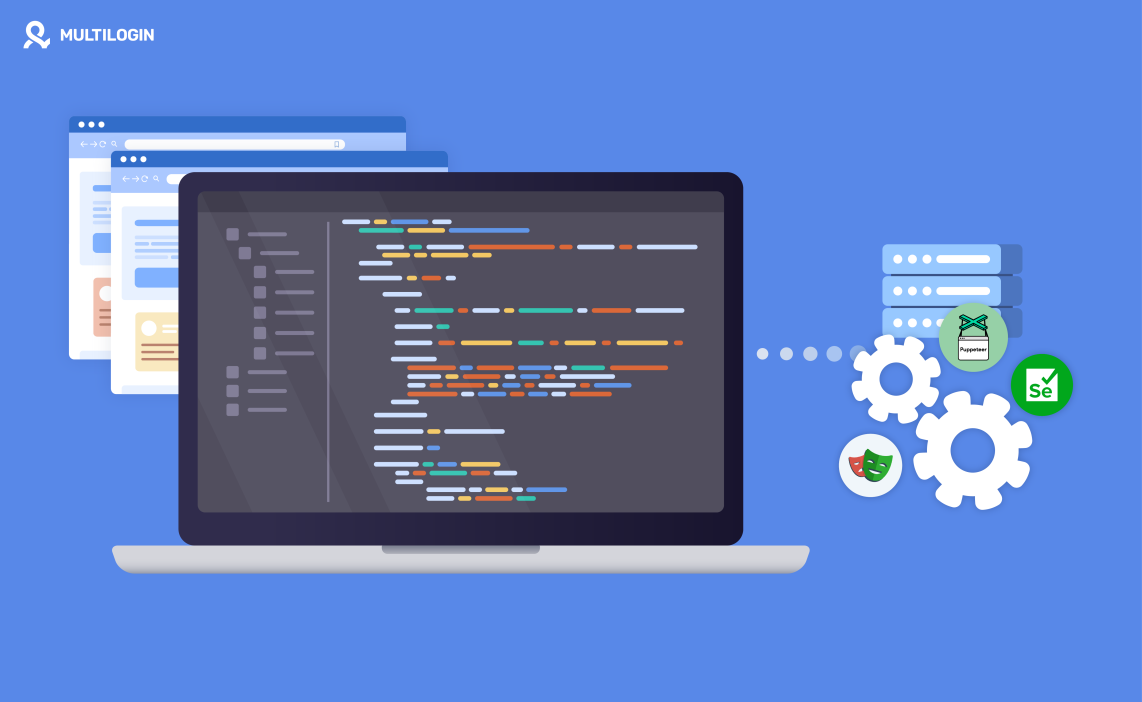Web scraping is essential for data collection, especially when dealing with large sets of information spread across multiple web pages. However, manually scraping data from websites can be time-consuming and tedious.
Automating this process allows you to gather valuable data quickly and efficiently. This guide covers various methods and tools to automate web scraping using Python, Power Automate, Selenium, and Chrome, and explains how to integrate more advanced solutions like Multilogin to avoid detection while scraping.
What is Web Scraping?
Web scraping is the process of extracting data from websites using software or scripts. Scraping involves accessing the HTML or API endpoints of a site to collect and analyze data, such as product prices, user reviews, social media posts, or news articles.
Many businesses and researchers use web scraping to gain insights into markets, monitor competitor pricing, and automate repetitive data collection tasks.
How to Automate Web Scraping
Web scraping can be automated using various programming languages, tools, and platforms. The right choice depends on the complexity of the website and the volume of data you need. Below, we’ll explore some of the most popular methods to automate web scraping.
Automate Web Scraping with Power Automate
Power Automate by Microsoft is an excellent option for users who prefer low-code platforms. Though it isn’t primarily designed for web scraping, it can be used for smaller-scale tasks like extracting data from websites, social media feeds, or financial data.
Steps to Automate Web Scraping with Power Automate:
Install Power Automate Desktop: Download and install the desktop version to automate processes on your machine.
Create a New Desktop Flow: Set up a flow for automating web scraping tasks.
Web Automation Actions: Use the built-in “Extract data from web page” action to capture the data you need.
Configure Repetitive Loops: Automate the process to scrape multiple pages by configuring loops that repeat the same scraping task across different web pages.
Export the Data: Export the scraped data into formats like CSV, Excel, or JSON for further analysis.
Power Automate is user-friendly, making it ideal for non-developers who want to start automating scraping tasks without writing code.
How to Automate Web Scraping Using Python
Python is one of the most popular languages for web scraping because of its simplicity and the vast ecosystem of libraries available. Libraries like BeautifulSoup and Scrapy make it easy to parse HTML and extract structured data.
Steps to Automate Web Scraping with Python:
Install Python Libraries: First, install essential Python libraries like BeautifulSoup, Requests, and Scrapy.
Python
pip install beautifulsoup4 requests scrapyWrite a Python Script: Use BeautifulSoup or Scrapy to write a web scraping script that automates data extraction from HTML or API endpoints.
Schedule the Script: Schedule your Python script using cron jobs (Linux) or Task Scheduler (Windows) to run at regular intervals.
Store the Scraped Data: You can easily export the scraped data to CSV, JSON, or databases like SQLite or MongoDB for analysis.
How to Automate Web Scraping in Chrome Using Selenium
Google Chrome is widely used for web scraping, especially for websites that heavily rely on JavaScript. Selenium is a powerful browser automation tool that can interact with dynamic content, filling forms, clicking buttons, and scrolling pages to collect data.
Steps to Automate Web Scraping in Chrome:
Install Selenium and ChromeDriver: First, install Selenium and ChromeDriver to interact with the browser.
Pythonpip install selenium Write a Selenium Script: Use Selenium to write a script that automates browser actions such as page navigation, scrolling, and clicking elements.
Schedule Your Script: You can schedule the script to run at specific times using cron or Task Scheduler.
Export the Data: Store the scraped data in files or databases for easy retrieval and analysis.
Automating Web Scraping with ChatGPT
While ChatGPT isn’t a scraping tool, you can use it to generate scripts that automate scraping tasks. For example, you can ask ChatGPT to create a Python script that scrapes product prices from an e-commerce site.
How to Use ChatGPT to Automate Web Scraping:
Prompt ChatGPT: Ask ChatGPT to generate a script for web scraping, such as scraping prices from Amazon or product details from eBay.
Modify the Script: Review and tweak the script based on your requirements.
Automate the Script: Once you have the working script, use task scheduling tools to automate the scraping process at regular intervals.
Advanced Web Scraping Using Multilogin
One challenge with web scraping is avoiding detection by websites. Most websites have anti-scraping measures that detect repetitive actions or unusual traffic patterns. Multilogin helps overcome this issue by enabling multiple browser profiles with distinct digital fingerprints.
How Multilogin Helps Automate Web Scraping:
Multiple Browser Profiles: Multilogin allows you to create isolated browser profiles that prevent websites from detecting that multiple scraping operations are being performed from the same machine.
Unique Digital Fingerprints: Each profile in Multilogin has its own digital fingerprint, such as IP address, user-agent, and browser version. This minimizes the risk of bans and blocks.
Seamless Proxy Integration: Multilogin integrates with proxies, allowing you to scrape websites from different IP addresses without detection.
This tool is perfect for businesses that need to scrape data from multiple sites while maintaining privacy and anonymity.
Best Tools to Automate Web Scraping
There are several tools available for automating web scraping, ranging from code-based solutions like Python libraries to no-code platforms. Here’s a list of the top tools:
Multilogin
Best For: Avoiding detection and scraping multiple websites without being blocked.
Features: Provides advanced fingerprinting technology, proxy integration, and browser profile isolation.
BeautifulSoup
Best For: Simple HTML parsing and data extraction.
Features: Easy to use, great for beginners, but not ideal for large-scale projects.
Scrapy
Best For: Advanced, large-scale scraping projects.
Features: Handles dynamic pages, scales well for large data extraction tasks.
Selenium
Best For: Scraping dynamic websites and interacting with JavaScript.
Features: Automates browser interactions such as clicking, scrolling, and form submission.
Octoparse
Best For: Non-programmers looking for a no-code solution.
Features: Visual scraper with cloud-based extraction and scheduling.
FAQs About Automating Web Scraping
Is Web Scraping Legal?
Web scraping is generally legal, but it depends on the terms of service of the website you’re scraping. Always review the website’s policies to avoid legal issues.
How Do I Automate Web Scraping Using Python?
Install Python libraries like BeautifulSoup or Scrapy, write a script to extract data, and automate the process using cron or Task Scheduler.
What is the Best Tool for Web Scraping?
For beginners, BeautifulSoup is an excellent choice. For more complex projects, Scrapy or Selenium is recommended.
Can You Use Power Automate for Web Scraping?
Yes, Power Automate can be used for small-scale web scraping tasks, although it’s not designed specifically for this purpose.
Final Thoughts
Python offers a comprehensive suite of tools for web scraping, from the simplicity of BeautifulSoup to the power and scalability of Scrapy. Each tool has its specific use case, and choosing the right one depends on the complexity and requirements of your project. Whether you’re scraping static pages or dynamically loaded content, Python has you covered.
For those concerned about detection and bans during large-scale scraping activities, integrating Multilogin into your workflow provides an additional layer of security. It enables you to manage multiple profiles and proxies, ensuring that your scraping operations remain undetected and efficient.



